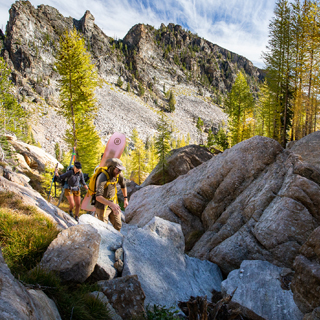Montana Forest and Conservation Experiment Station
The Montana Forest and Conservation Experiment Station is the statewide agency research unit of the W.A. Franke College of Forestry and Conservation. The MFCES was founded in 1937 and provides base funding for an active research program at the college. That research addresses issues Montanans care about, like water availability and forest management.
The MFCES owns and manages two properties, Lubrecht Experimental Forest and Bandy Ranch. Both are actively managed for timber and grazing and serve as outdoor laboratories for the college's students and faculty.
Managing Montana’s resources requires a diverse and interdisciplinary team. We’ve got some amazing individuals here in the college capable of addressing these topics. And we have amazing assets in our state: the largest freshwater lake west of the Mississippi, broad opportunities to hunt and fish and some of the nation’s largest contiguous forestlands – just to name a few.
Yet every year we are faced with new and complex issues that create challenges to the sustainable management of our state’s rangelands, forests and water. The Montana Forest and Conservation Experiment Station helps us address these challenges.
For example:
- In July, 2016, at least 10 Montana counties were in a state of severe drought – the most severe category – according to the Governor’s Drought and Water Supply Advisory Committee
- 2016 was considered an average fire season in Montana, but in 2015 we burned an above-average 350,000 acres here and more than 10 million acres nationally (source: Bozeman Chronicle). Even an average fire year costs Montana taxpayers between $2 and $3 million to fight fires (source: Montana Public Radio interview with Mike DeGrosky, currently state’s Fire and Aviation Bureau Chief and W.A. Franke CFC alum)
The team needed to address these challenges and others is a strong partnership of state and federal land managers, local agencies, private industry and landowners and us – the researchers and educators who are investigating these issues and training the next generation of land managers to deal with them.
The Montana Forest & Conservation Experiment Station is helping Montana's natural resources. Here are a few examples:
Our state climatologist, professor Kelsey Jencso, traveled across the state to set up a network of weather stations on private ranch lands and ag experiment stations. The Montana Mesonet provides hourly reports of moisture, temperature and soils at four depths, as well as rainfall, solar intensity, wind, temperature, relative humidity and barometric pressure. The information supports the optimization of crop timing, monitoring of available water, irrigation efficiency, fertilizer management, stock management, and identification of pending drought conditions. Mesonets in other states have resulted in millions of dollars of improved profitability statewide.
One of our recent graduates, Mike Schaedel, published his research on how well thinned forests store carbon versus un-thinned forests. His results are somewhat surprising: conventional wisdom tells us that an un-thinned forest, full of more trees, would store more carbon in that more dense tree canopy. Instead, Mike found that pre-commercially thinned stands actually store the same amount of carbon as an un-thinned forest. So now we can help landowners both manage their timber resources for good economic sense AND meet carbon storage goals. (Source: Forest Ecology and Management)
Students in some of our forestry courses have spent the last few semesters trying to better understand our timber and rangeland assets at Bandy Ranch, a MFCES property in the Blackfoot Valley. They’ve successfully partnered with local organizations (Trout Unlimited, US Fish and Wildlife Service, neighboring landowners) to design, propose and get funding for a new bridge across a cutthroat trout stream that flows directly into the Blackfoot River. The new bridge and improved culvert system not only provide better passage for the fish, but now logging trucks can get across the stream into the heart of the ranch to do logging – part of another student project to plan and manage timber sales on the property.
For every dollar of this state support, our research faculty bring in $8 dollars in other funds, from federal and state grants and private contracts.
In 2017, we have more than $20 million in active external grants from federal agencies and more than $5 million from other sources including other universities, private foundations and private companies.
Much of that support is only possible because of the strong base support for forestry and conservation research from the state.
MFCES Director
Alan Townsend
406-243-5521 | alan.townsend@umontana.edu
MFCES Executive Director
Scott Ferrenberg
406-243-6051 | scott.ferrenberg@umontana.edu
